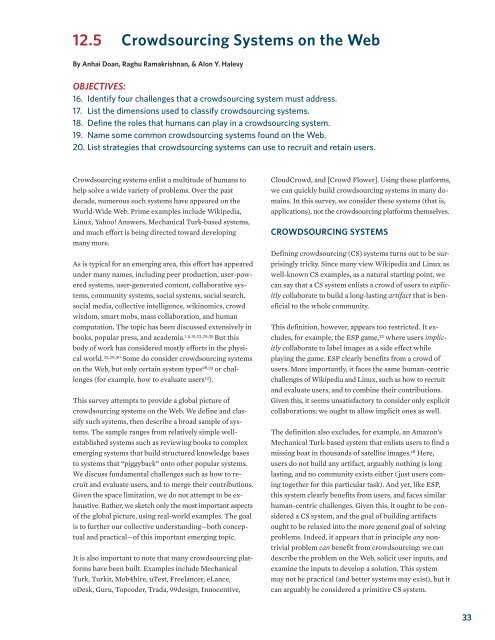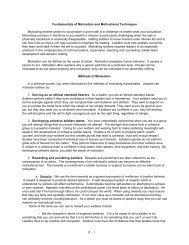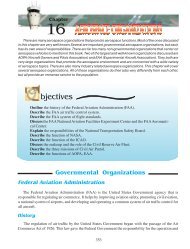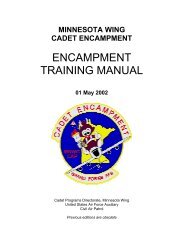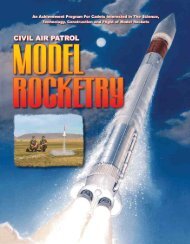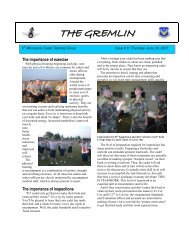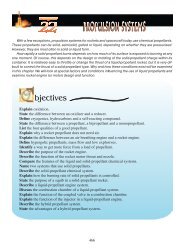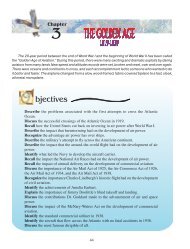focal point for describing and integrating these keystrategic elements.• Top management discussions to arrive at a drivingforce bring to the surface issues that must be resolved ifan organization is going to arrive at an effective strategystatement. An approach that allows top management tostop short of this will facilitate agreement, but will alsoresult in a general statement of strategy that is no moreuseful than those previously illustrated.• Every organization has a momentum that carries it ina certain direction. This momentum is generated by thedriving force. Unless the driving force is recognized, attemptsto change this direction will be futile. You mustknow from what you are changing. The driving force providesthe basic means for thinking about alternative futuresand what each might mean in terms of products,markets, capabilities, and return.• The concept of driving force also has great value intracking the competition. Since there generally is no wayto know the stated strategy of your competitors, assumingthey have one, simply observe their actions to determinetheir driving force and then project what their futurecourses of action might be.ABOUT THE AUTHORSBenjamin B. Tregoe, Jr., is chairman of the board of directorsand chief executive officer of Kepner-Tregoe, Inc., aninternational management education and organization developmentfirm located in Princeton, New Jersey. Formerlyassociated with the Rand Corporation, Dr. Tregoe and hiscolleague, Charles H. Kepner, Ph.D., developed the Kepner-Tregoe Rational Process – the application of cause-effectlogic to management activities.John W. Zimmerman is senior vice-president of the Kepner-Tregoe organization, where his responsibilities include newconceptual research and various aspects of corporate businessdevelopment. Over the last five years he has specializedwith Dr. Tregoe in the development of a program tohelp chief executive officers clearly determine the futurenature and direction of their businesses.From: Benjamin B. Tregoe and John W. Zimmerman, “StrategicThinking: Key to Corporate Survival,” Management Review 68, no. 2(1979): 8-14. Used with permission.The rate of change and the complexity of today’sworld make strategic thinking essential to survival. However,the vehicle that organizations generally have used tocope with the future – long-range planning - is in manyways primarily responsible for stifling their ability to surviveand triumph over the challenges ahead. Long-rangeplanning is killing strategic thinking.Strategic thinking must be separated from and precedelong and short-range operational planning. Strategicthinking must result in a statement of strategy that is specific,simple, and clear enough to provide a framework forthe determination of future products, markets, capabilities,and return. The driving force is the key to developingsuch a statement.The chief executives we know voice an increasingsense of urgency about the importance of clear strategicthinking and about their own role in the strategy formulationprocess. For this urgency to be translated into effectiveaction, top management must devote its most seriousand incisive thinking to strategic issues.32
12.5 Crowdsourcing Systems on the WebBy Anhai Doan, Raghu Ramakrishnan, & Alon Y. HalevyOBJECTIVES:16. Identify four challenges that a crowdsourcing system must address.17. List the dimensions used to classify crowdsourcing systems.18. Define the roles that humans can play in a crowdsourcing system.19. Name some common crowdsourcing systems found on the Web.20. List strategies that crowdsourcing systems can use to recruit and retain users.Crowdsourcing systems enlist a multitude of humans tohelp solve a wide variety of problems. Over the pastdecade, numerous such systems have appeared on theWorld-Wide Web. Prime examples include Wikipedia,Linux, Yahoo! Answers, Mechanical Turk-based systems,and much effort is being directed toward developingmany more.As is typical for an emerging area, this effort has appearedunder many names, including peer production, user-poweredsystems, user-generated content, collaborative systems,community systems, social systems, social search,social media, collective intelligence, wikinomics, crowdwisdom, smart mobs, mass collaboration, and humancomputation. The topic has been discussed extensively inbooks, popular press, and academia. 1,5,15,23,29,35 But thisbody of work has considered mostly efforts in the physicalworld. 23,29,30 Some do consider crowdsourcing systemson the Web, but only certain system types 28,33 or challenges(for example, how to evaluate users 12 ).This survey attempts to provide a global picture ofcrowdsourcing systems on the Web. We define and classifysuch systems, then describe a broad sample of systems.The sample ranges from relatively simple wellestablishedsystems such as reviewing books to complexemerging systems that build structured knowledge basesto systems that “piggyback” onto other popular systems.We discuss fundamental challenges such as how to recruitand evaluate users, and to merge their contributions.Given the space limitation, we do not attempt to be exhaustive.Rather, we sketch only the most important aspectsof the global picture, using real-world examples. The goalis to further our collective understanding—both conceptualand practical—of this important emerging topic.It is also important to note that many crowdsourcing platformshave been built. Examples include MechanicalTurk, Turkit, Mob4hire, uTest, Freelancer, eLance,oDesk, Guru, Topcoder, Trada, 99design, Innocentive,CloudCrowd, and [Crowd Flower]. Using these platforms,we can quickly build crowdsourcing systems in many domains.In this survey, we consider these systems (that is,applications), not the crowdsourcing platforms themselves.CROWDSOURCING SYSTEMSDefining crowdsourcing (CS) systems turns out to be surprisinglytricky. Since many view Wikipedia and Linux aswell-known CS examples, as a natural starting point, wecan say that a CS system enlists a crowd of users to explicitlycollaborate to build a long-lasting artifact that is beneficialto the whole community.This definition, however, appears too restricted. It excludes,for example, the ESP game, 32 where users implicitlycollaborate to label images as a side effect whileplaying the game. ESP clearly benefits from a crowd ofusers. More importantly, it faces the same human-centricchallenges of Wikipedia and Linux, such as how to recruitand evaluate users, and to combine their contributions.Given this, it seems unsatisfactory to consider only explicitcollaborations; we ought to allow implicit ones as well.The definition also excludes, for example, an Amazon’sMechanical Turk-based system that enlists users to find amissing boat in thousands of satellite images. 18 Here,users do not build any artifact, arguably nothing is longlasting, and no community exists either ( just users comingtogether for this particular task). And yet, like ESP,this system clearly benefits from users, and faces similarhuman-centric challenges. Given this, it ought to be considereda CS system, and the goal of building artifactsought to be relaxed into the more general goal of solvingproblems. Indeed, it appears that in principle any nontrivialproblem can benefit from crowdsourcing: we candescribe the problem on the Web, solicit user inputs, andexamine the inputs to develop a solution. This systemmay not be practical (and better systems may exist), but itcan arguably be considered a primitive CS system.33
- Page 1 and 2: VOLUME FOUR STRATEGIC PERSPECTIVESL
- Page 3 and 4: VOLUME FOUR STRATEGIC PERSPECTIVESL
- Page 5 and 6: VOLUME FOUR STRATEGIC PERSPECTIVESL
- Page 7: VOLUME FOUR STRATEGIC PERSPECTIVESL
- Page 10 and 11: 12CHAPTER 12INTRODUCTION TO STRATEG
- Page 12 and 13: 12.1 Strategic Leadership: Defining
- Page 14 and 15: mandates or resolutions that would
- Page 16 and 17: and ambiguity, aspiring strategic l
- Page 18 and 19: 12.2 National Security StrategyThe
- Page 20 and 21: within our borders has always been
- Page 22 and 23: front common challenges like violen
- Page 24 and 25: and our strategy, not sector earmar
- Page 26 and 27: thinking about organizations. She m
- Page 28 and 29: A systemic approach to failure is m
- Page 30 and 31: The late W. T. Grant Company is a r
- Page 32 and 33: the resources - setting the directi
- Page 36 and 37: Consequently, we do not restrict th
- Page 38 and 39: paragraphs, Web pages, then edit an
- Page 40 and 41: Web, can be viewed as a CS attempt
- Page 42 and 43: How to evaluate users and contribut
- Page 44 and 45: 13CHAPTER 13LEADING PUBLIC &VOLUNTE
- Page 46 and 47: 13.1 Leadership for Volunteers:The
- Page 48 and 49: 13.2 Take Root: Volunteer Managemen
- Page 50 and 51: QualificationsClearly list educatio
- Page 52 and 53: and effectively track their volunte
- Page 54 and 55: • Understand rules for recognitio
- Page 56 and 57: • Send a birthday card.• Submit
- Page 58 and 59: and tested more than six decades af
- Page 60 and 61: specific interests of the donors, v
- Page 62 and 63: tain) tax-exempt status from the In
- Page 64 and 65: Smucker, 1999).The Internal Revenue
- Page 66 and 67: culture is necessary to ensure the
- Page 68 and 69: 13.4 The New Look of TransparencyBy
- Page 70 and 71: ees for a couple of reasons: One, i
- Page 72 and 73: 13.5 Public and Private Management:
- Page 74 and 75: TABLE 1:FUNCTIONS OF GENERAL MANAGE
- Page 76 and 77: 3. Career System. The model corpora
- Page 78 and 79: islative charter - the Clean Air Ac
- Page 80 and 81: In controlling performance, Chapin
- Page 82 and 83: 14CHAPTER 14AIRPOWER ASSTRATEGIC LA
- Page 84 and 85:
14.1 Strategic Air Power: Fulfillme
- Page 86 and 87:
carry it out. Their daylight raids
- Page 88 and 89:
you did not rely on strategic bombi
- Page 90 and 91:
14.2 Warden and the Air Corps Tacti
- Page 92 and 93:
ecomes one of applying sufficient i
- Page 94 and 95:
tification, and a Jominian claim to
- Page 96 and 97:
courage the rapid and widespread ex
- Page 98 and 99:
it to influence physical players in
- Page 100 and 101:
14.4 Basic Air Force DoctrineAF Doc
- Page 102 and 103:
earthquake-stricken Haiti. The worl
- Page 104 and 105:
perspective. Airmen do not divide u
- Page 106 and 107:
Command and ControlCommand and cont
- Page 108 and 109:
14.5 Should the US Maintain the Nuc
- Page 110 and 111:
form of human government.” 20 Dem
- Page 112 and 113:
obtainable goal. See the Global Zer
- Page 114 and 115:
15CHAPTER 15ORGANIZATIONAL CULTURE
- Page 116 and 117:
15.1 Organizational CultureBy Doria
- Page 118 and 119:
Review. This action strives to unco
- Page 120 and 121:
gram will serve and then having the
- Page 122 and 123:
ticipating the changes being made b
- Page 124 and 125:
Many years of working with change p
- Page 126 and 127:
At the least, the areas of concern
- Page 128 and 129:
15.4 Developing an Innovative Cultu
- Page 130 and 131:
CONCLUDING THOUGHTSIn an ever-chang
- Page 132 and 133:
global issues. Businesses that poss
- Page 134 and 135:
— Sees the big picture—the shif
- Page 136 and 137:
16CHAPTER 16STRATEGIC COMMUNICATION
- Page 138 and 139:
16.1 Principles of Strategic Commun
- Page 140 and 141:
16.2 The Art of NegotiationBy Brend
- Page 142 and 143:
16.3 Negotiating Effectively Across
- Page 144 and 145:
hidden areas can act as cultural ho
- Page 146 and 147:
and four conflict styles. Hammer be
- Page 148 and 149:
maintaining the relationship. As th
- Page 150 and 151:
25 Mitchell R. Hammer, “Chapter 1
- Page 152 and 153:
tural, socioeconomic, and psycholog
- Page 154 and 155:
for the win-win," during which time
- Page 156 and 157:
interests and, at worst, as a gun s
- Page 158 and 159:
Public diplomacy is surely about mu
- Page 160 and 161:
But public diplomats do not have th
- Page 162 and 163:
Photo courtesy of the familyThe LEA
- Page 164:
THE CADET OATHI pledge that I will


